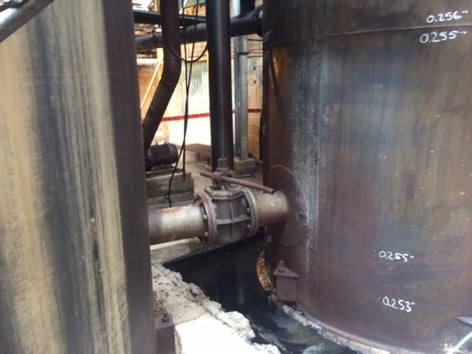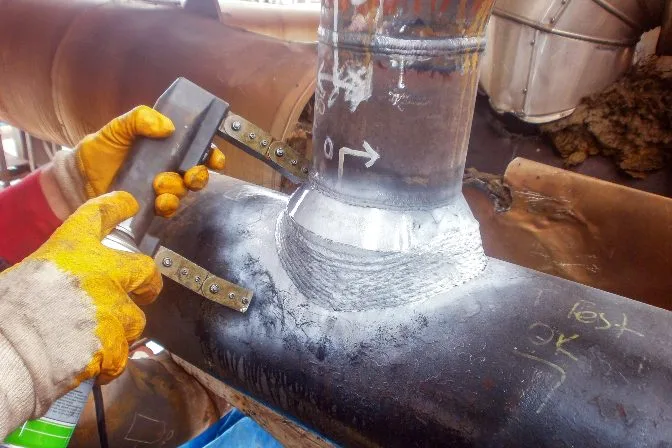Why Regular Tank Welding Inspection is Important for Architectural Stability
Why Regular Tank Welding Inspection is Important for Architectural Stability
Blog Article
The Important Role of Tank Welding Inspection in Ensuring Structural Honesty and Safety And Security Compliance in Industrial Applications
In the world of industrial applications, container welding assessment emerges as a pivotal component in securing architectural integrity and ensuring conformity with safety and security guidelines. Using a mix of methods such as visual analyses and advanced screening techniques, these examinations serve to recognize and alleviate potential imperfections prior to they intensify right into considerable hazards. The effects of these methods expand beyond simple governing adherence; they fundamentally effect operational performance and possession long life. The complexities bordering the inspection procedure motivate a closer evaluation of its methods and outcomes, exposing layers of relevance that merit more expedition.
Relevance of Container Welding Inspection

Making certain compliance with market requirements and guidelines is an additional significant aspect of tank welding assessment. Regulative bodies mandate strict guidelines for the building and construction and upkeep of storage tanks, and comprehensive evaluations assist organizations comply with these requirements. Non-compliance can cause serious charges, including penalties and shutdowns, further stressing the requirement for rigorous inspection procedures.
Additionally, tank welding examination plays a critical duty in keeping operational performance. In recap, the relevance of container welding assessment exists in its capacity to safeguard public health and wellness, safeguard the setting, and make certain conformity with regulative structures.
Trick Assessment Strategies
Reliable tank welding inspection relies on a range of essential methods that make certain complete evaluation of weld quality and structural integrity. Among the most widespread strategies are aesthetic assessment, ultrasonic screening, radiographic screening, and magnetic fragment screening - Tank Welding Inspection. Each technique offers distinct advantages in evaluating various elements of the weld
Visual evaluation functions as the first line of protection, permitting inspectors to recognize surface area problems, abnormalities, or disparities in the weld bead. Ultrasonic screening employs high-frequency acoustic waves to find internal imperfections, such as splits or spaces, supplying an extensive assessment of weld integrity. This approach is specifically reliable in spotting problems that may not show up externally.
Radiographic testing utilizes X-rays or gamma rays to generate pictures of the welds, disclosing interior suspensions and providing an irreversible document for future recommendation. This technique is very efficient for critical applications where the danger of failure need to be minimized.
Lastly, magnetic particle screening is employed to determine surface and near-surface flaws in ferromagnetic products. By applying magnetic areas and great iron particles, inspectors can pinpoint discontinuities navigate to this site that may compromise the architectural stability of the tank. With each other, these techniques develop a durable framework for ensuring top notch welds in commercial applications.
Compliance With Security Specifications

Routine examinations play a pivotal role in making sure conformity by recognizing possible failings or inconsistencies from recommended criteria. Assessors are educated to review weld top quality, confirm material requirements, and analyze the total architectural honesty of tanks. Their experience is important in making visit here certain that welding procedures fulfill the called for security criteria.
Moreover, compliance with safety standards not only protects employees but also safeguards the environment from prospective threats such as leakages or tragic failings. Organizations that focus on safety compliance are better placed to reduce dangers, enhance functional efficiency, and foster a society of security within their workforce. In summary, preserving extensive compliance with safety standards is important for the successful operation of container welding activities in commercial settings.
Benefits of Normal Inspections
Routine examinations are important to preserving the architectural stability and safety of bonded tanks. These assessments give a systematic strategy to recognizing possible flaws or weaknesses in the welds, ensuring that any kind of problems are dealt with before they intensify right into substantial failings. By conducting regular evaluations, organizations can detect rust, tiredness, and other forms of degeneration that may jeopardize tank efficiency.
Furthermore, regular assessments contribute to compliance with industry laws and standards. Complying with these guidelines not just mitigates legal threats however likewise improves the company's online reputation for safety and published here security and reliability. Regular assessments foster a proactive safety and security culture, encouraging workers to recognize and focus on the value of tools integrity.

Case Researches and Real-World Applications
Case research studies and real-world applications illustrate the substantial influence of effective tank welding inspection methods. Following the execution of rigorous welding examination protocols, including visual and ultrasonic screening, the facility determined important imperfections in weld seams that can have led to catastrophic failings.
Likewise, a water therapy plant applied an extensive inspection program for its storage tank welding operations - Tank Welding Inspection. By incorporating non-destructive screening approaches, the plant was able to detect early indicators of rust and exhaustion in weld joints. This prompt treatment extended the life expectancy of the storage tanks and ensured conformity with safety and security guidelines, thus protecting public health and wellness
These study highlight the value of routine and systematic container welding examinations. By prioritizing these practices, markets can reduce threats, improve structural honesty, and make sure compliance with security criteria, eventually causing boosted operational efficiency and lowered obligations.

Verdict
In final thought, storage tank welding assessment is a crucial part of keeping structural honesty and security in commercial applications. Utilizing various inspection techniques guarantees early discovery of potential problems, thereby stopping catastrophic failings.
Report this page